
In circuit shown in figure the current through

A. the \[3\Omega \] resistor is \[0.50A\]
B. the \[3\Omega \] resistor is \[0.25A\]
C .the \[4\Omega \] resistor is \[0.50A\]
D. the \[4\Omega \]resistor is \[0.25A\]
Answer
217.5k+ views
Hint: The resistor's voltage V in volts (V) divided by its resistance R in ohms (R) gives rise to the resistor's current I in amps (A): V is the voltage drop of the resistor, expressed in Volts (V). Voltage is sometimes represented by the letter E in Ohm's law.
Formula used:
Complete answer:
We have been provided in the question that the current through the circuit is,
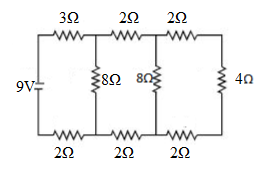
To begin, we will calculate the equivalent resistance of the resistors in the circle.
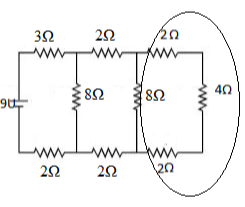
These resistances are connected in series. As a result, their equivalent resistance is equal to \[2\Omega + 4\Omega + 2\Omega = 8\Omega \] according to the formula. This equivalent resistor, together with the resistor in the box, yields an equivalent resistor of \[{\left( {\frac{1}{{8{\rm{\Omega }}}} + \frac{1}{{8{\rm{\Omega }}}}} \right)^{ - 1}} = 4{\rm{\Omega }}\]
This is depicted in the following figure.
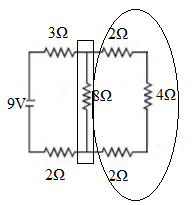
Repeating the process for the resistors in the circle and box, we get the equivalent resistance of the resistors in the circle as \[2\Omega + 4\Omega + 2\Omega = 8\Omega \], and the equivalent resistance of this and the resistor in the box as \[{\left( {\frac{1}{{8{\rm{\Omega }}}} + \frac{1}{{8{\rm{\Omega }}}}} \right)^{ - 1}} = 4{\rm{\Omega }}\].
This is depicted in the following figure.
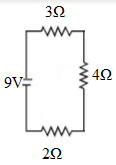
We can observe that the overall resistance in the circuit is
\[2\Omega + 4\Omega + 3\Omega = 9\Omega \]
As per Ohm's law, the current flowing through in this circuit will now be
\[V = IR\]
On solving for I, we can write as
\[I = \frac{V}{R}\]
Now, we have to substitute the value we get
\[ = \frac{{9V}}{{9{\rm{\Omega }}}}\]
On simplifying the above equation, we get
\[ = 1A\]
Returning to the original circuit, the resistance on both routes is equal, therefore the current divides equally once more.
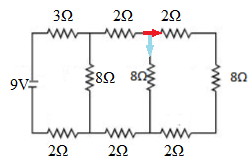
This gives us the current through the \[3\] ohm resistor as \[1\] amp and the current through the 4 ohm resistor as \[0.25\] amp
As a result, the current will be divided equally.
Hence, the option B is correct
Note: Keep in mind that current does not always split evenly between the two branches of the circuit. It is determined by the amount of resistance between them. The current was equally distributed in this case because the resistance on the different branches of the circuit was equal.
Formula used:
Complete answer:
We have been provided in the question that the current through the circuit is,

To begin, we will calculate the equivalent resistance of the resistors in the circle.

These resistances are connected in series. As a result, their equivalent resistance is equal to \[2\Omega + 4\Omega + 2\Omega = 8\Omega \] according to the formula. This equivalent resistor, together with the resistor in the box, yields an equivalent resistor of \[{\left( {\frac{1}{{8{\rm{\Omega }}}} + \frac{1}{{8{\rm{\Omega }}}}} \right)^{ - 1}} = 4{\rm{\Omega }}\]
This is depicted in the following figure.

Repeating the process for the resistors in the circle and box, we get the equivalent resistance of the resistors in the circle as \[2\Omega + 4\Omega + 2\Omega = 8\Omega \], and the equivalent resistance of this and the resistor in the box as \[{\left( {\frac{1}{{8{\rm{\Omega }}}} + \frac{1}{{8{\rm{\Omega }}}}} \right)^{ - 1}} = 4{\rm{\Omega }}\].
This is depicted in the following figure.

We can observe that the overall resistance in the circuit is
\[2\Omega + 4\Omega + 3\Omega = 9\Omega \]
As per Ohm's law, the current flowing through in this circuit will now be
\[V = IR\]
On solving for I, we can write as
\[I = \frac{V}{R}\]
Now, we have to substitute the value we get
\[ = \frac{{9V}}{{9{\rm{\Omega }}}}\]
On simplifying the above equation, we get
\[ = 1A\]
Returning to the original circuit, the resistance on both routes is equal, therefore the current divides equally once more.

This gives us the current through the \[3\] ohm resistor as \[1\] amp and the current through the 4 ohm resistor as \[0.25\] amp
As a result, the current will be divided equally.
Hence, the option B is correct
Note: Keep in mind that current does not always split evenly between the two branches of the circuit. It is determined by the amount of resistance between them. The current was equally distributed in this case because the resistance on the different branches of the circuit was equal.
Recently Updated Pages
Addition of Three Vectors: Methods & Examples

Addition of Vectors: Simple Guide for Students

Algebra Made Easy: Step-by-Step Guide for Students

Relations and Functions: Complete Guide for Students

Analytical Method of Vector Addition Explained Simply

Arithmetic, Geometric & Harmonic Progressions Explained

Trending doubts
JEE Main 2026: Application Form Open, Exam Dates, Syllabus, Eligibility & Question Papers

Derivation of Equation of Trajectory Explained for Students

Hybridisation in Chemistry – Concept, Types & Applications

Understanding the Angle of Deviation in a Prism

Understanding Collisions: Types and Examples for Students

How to Convert a Galvanometer into an Ammeter or Voltmeter

Other Pages
JEE Advanced Marks vs Ranks 2025: Understanding Category-wise Qualifying Marks and Previous Year Cut-offs

Understanding Atomic Structure for Beginners

Ideal and Non-Ideal Solutions Explained for Class 12 Chemistry

Degree of Dissociation: Meaning, Formula, Calculation & Uses

Understanding Electromagnetic Waves and Their Importance

Understanding the Electric Field of a Uniformly Charged Ring




